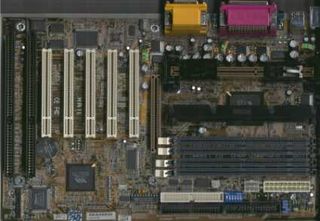21 Slot-1 Motherboards using VIA Chipsets
FIC KA11
Board Revision: 2.2
BIOS Version: qm413

First International Computer offers their KA11 motherboard using the VIA Apollo Pro 133A. I'll start with the manual this time, which is well structured and rather comprehensive, making it also suited for beginners. The package also contains Norton Ghost, Norton Anti Virus and Norton Virtual Drive, which some people could really appreciate.
This board seems to be able to fulfill most users' requirements: 5 PCI slots, two ISA slots, four DIMM sockets (1 GB max.), Creative sound chip, standard I/O (2 serial, 1 parallel, 2 USB), UltraDMA/66, ECC support, three fan headers, Wake on LAN, AGP 4x and FSB speeds up to 150 MHz are pretty good. The FSB speed type (66, 100, 133 MHz) is detected automatically. Still you can change this setting in the BIOS, but the AGP and PCI dividers cannot be altered this way. So I couldn't run a 100 MHz CPU at 133/33 MHz, but "only" at 133/44 MHz, with the AGP running at 88 MHz. As a result, the system didn't want to start. Of course the 'A14'-procedure would have got me around that.
Multiplier and CPU voltage can be set by DIPswitches (multiplier) and some jumpers (Vcore). Voltage can be altered between 1.3 and 2.05V in 0.05V increments or between 2.1 and 3.5V in 0.1V increments. FIC makes use of a BIOS write protection system called BIOS Guardian. It is enabled within the BIOS Features Setup. You are given the option to disable AGP Fast Writes. In addition, the board comes with FIC's LogoGeenie, which allows the user or admin to create their own startup logo. This bmp-picture (640x464x4) will be displayed while the system is initializing and booting.
Our sample board is not equipped with the additional USB connectors. If they were present, you could make use of two more USB ports by obtaining the right cable. FIC already installed the CPU retention system and locks. Removing the CPU is not as easy as with other boards, since the locks have to be retired manually until the CPU has been removed.
The KA11 is definitely one of the faster boards that you will see in the benchmark charts later. I'm a bit upset that these good results are blurred by the fact that Windows NT benchmarking failed. Even with the slowest BIOS settings I repeatedly got blue screens. It seems as if Windows NT benchmarking is becoming a stability test for some motherboards, since the Chaintech board had some problems also.
Stay on the Cutting Edge
Join the experts who read Tom's Hardware for the inside track on enthusiast PC tech news — and have for over 25 years. We'll send breaking news and in-depth reviews of CPUs, GPUs, AI, maker hardware and more straight to your inbox.
Most Popular

